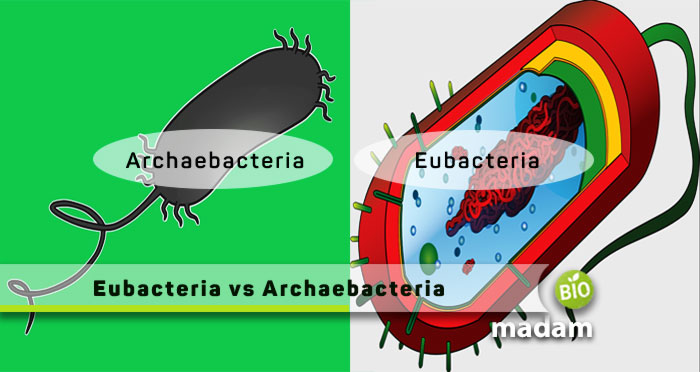Eubacteria and Archaebacteria are two classifications of the Kingdom Monera. Kingdom Monera contains the least organized prokaryotic unicellular microorganisms.
The word “Archaebacteria” roughly translates to Ancient bacteria, while “Eubacteria” means True bacteria. Archaebacteria are found in extreme conditions, whereas eubacteria are present all over Earth.
Both bacteria are similar to each other, having flagella, as they belong to the least organized unicellular prokaryotes. Yet, they are also very different in many aspects. Let’s tell you everything about Eubacteria and Archaebacteria considering all the similarities and differences.
Comparison Table
| Characteristics | Archaebacteria | Eubacteria |
| Meaning | Ancient bacteria | True bacteria |
| Types | Halophiles, thermophiles, and methanogens | Gram-positive, and gram-negative |
| Habitat | Hot water springs, and salty areas | In the environment & human body |
| Shapes | Spheres, rods, spirals, plates, etc. | Bacilli, cocci, rods, vibrio, etc. |
| Cell Wall | Pseudo peptidoglycans | Peptidoglycans and Muramic acid |
| Introns | Present | Absent |
| Polymerase Pattern | Complex | Simple |
| Glycolysis and Krebs cycle | Absent | Present |
| Reproduction | Asexual | Sexual & asexual |
| Humans Pathogenicity | Absent | Present |
What is Archaebacteria?
Archaebacteria sometimes referred to as archaea, are mostly believed to be the first bacteria that occurred on the face of Earth. They are found widely in soils, oceans, marshlands, and extreme conditions like hot springs and oceans. Some kinds of these bacteria also exist in humans, including the oral cavity, skin, and colon (the longest part of the large intestine). They are very small in size, around 0.1 to 15 microns, and are found in various shapes such as spheres, rods, flat plates, squares, and spirals.
Archaebacteria are not seen to be parasitic or pathogenic and play a major role in the nitrogen and carbon cycle. They lack sex chromosomes but only have one chromosome for genetic exchange. Their structure is made of pseudo peptidoglycans, which means that the cell wall does not have real peptidoglycans in them. Their structure is quite similar to the structure of gram-positive bacteria.
There are three types of archaebacteria commonly found: halophiles, methanogens, and thermophiles. Halophiles are usually present in salt lakes and salty water areas, methanogens live in oxygen-free environments like marshlands, and thermophiles prefer hot water areas like springs. These bacteria typically reproduce asexually by binary fission, fragmentation, or budding.
What is Eubacteria?
As the name indicates, Eubacteria were found following Archaebacteria and are called true bacteria. Unlike Archaebacteria, which exist only in extreme conditions, Eubacteria are found almost everywhere on Earth. They are 0.5 to 5 microns in size and come in numerous shapes and forms like the Cocci, bacilli, rods, vibrio, filaments, etc.

They also exhibit parasitic behavior sometimes and are involved in the nitrogen cycle. Just like archaebacterial, eubacteria also have single DNA in the form of circular chromosomes. They lack membrane-bound organelles, like mitochondria and chloroplast, and have ester linkages of straight-chain fatty acids in their cell membrane. They have peptidoglycans in their cell wall with muramic acid. While the former kind of bacteria does not have any further categorization, eubacteria are classified as gram-positive and gram-negative bacteria depending on their characteristics.
The names Gram-positive and Gram-negative come from their ability to react with the stain. Gram-positive bacteria react with the gram stain and take the color of the stain. In contrast, gram-negative bacteria have a complex wall structure and do not react with the stain, thus the name of gram-negative bacteria. These bacteria reproduce asexually through spores as well as some sexual means like conjugation.
Eubacteria have a few more complex features that make them more advanced bacteria than archaebacteria. Eubacteria also exhibit Krebs’ cycle and glycolysis. However, the former does not possess Introns; they are present in Archaebacteria.
Similarities between Eubacteria and Archaebacteria
Both bacteria niches are quite distinct in habitat, structure, and function, yet they have two similarities.
- Eubacteria and Archaebacteria are unicellular bacteria belonging to the Kingdom Monera.
- Both are prokaryotic, meaning they are made of a single chromosome and do not have any membrane-bound organelle like a nucleus and mitochondria.
Difference between Archaebacteria and Eubacteria
Despite belonging to the same Kingdom, they have numerous differences, including:
Name Origin
Archaebacteria
Archaebacteria are given the given because they are thought to be the most primitive form of bacteria on Earth. Archae means ancient or old.
Eubacteria
Eubacteria meaning True bacteria are better organized than archaebacteria.
Types
Archaebacteria
Archaebacteria are categorized into three types depending on their habitat; halophiles, methanogens, and thermophiles.
Eubacteria
According to their cell wall complexity, eubacteria are further classified into gram-positive and gram-negative bacteria.
Habitat
Archaebacteria
Though they are the most primitive bacteria found on Earth, they are not typical and present in hot water springs, salty areas, and areas with low oxygen.
Eubacteria
Eubacteria are present everywhere around us, and some are also found in the human body, like the oral cavity and colon.
Shape
Archaebacteria
They are found in various shapes, including spheres, rods, spirals, plates, and square-shaped archaebacteria.
Eubacteria
They are present in shapes like bacilli, cocci, rods, vibrio, filaments, and spirochetes.

Cell Wall
Archaebacteria
Archaebacteria contain a cell wall made of pseudo peptidoglycans. It is without the presence of any other compound, thus lacking a true structure.
Eubacteria
Eubacteria, a prokaryote, have a cell wall made of peptidoglycans along with muramic acid. They have straight-chain fatty acid ester linkages.
Introns
Archaebacteria
Archaebacteria have introns and exons that help in the assembly of new genes quickly.
Eubacteria
Introns are not present in eubacteria.
RNA Polymerase
Archaebacteria
Archaebacteria have a complex subunit RNA polymerase pattern similar to the RNA polymerase of eukaryotic cells.
Eubacteria
They do not have a complex RNA polymerase. Instead, it consists of a simple, straightforward subunit pattern.
Glycolysis/ Kreb’s cycle
Archaebacteria
These bacteria do not exhibit Kreb’s cycle or glycolysis
Eubacteria
They exhibit glycolysis and Krebs’ cycle.
Reproduction
Archaebacteria
Archaebacteria reproduce by asexual methods only like binary fission, budding, and fragmentation.
Eubacteria
Eubacteria reproduce through sexual and asexual reproduction. Reproduction methods include fragmentation, fission, budding, and spores to stay dormant in unfavorable conditions.
Pathogenic Activity
Archaebacteria
They do not possess any parasitic or pathogenic activity in humans.
Eubacteria
Eubacteria (gram-positive and gram-negative) bacteria have pathogenic effects on humans that are mostly escaped from probiotics, so antibiotics are used. Such medicines help treat possible infections and diseases, however, these do not have any impact on archaebacteria.
The Bottom Line
Archaebacteria and eubacteria are unicellular prokaryotes and belong to the same Kingdom, yet possess many differences. Their habitats are different, and they reproduce in different ways. You can find archaebacteria in rods, filaments, and sphere shapes, while eubacteria are more common in cocci and bacilli forms. While eubacteria are pathogenic, some of them are good for human health. Archaebacteria are not very common and are found in marshes and hot water springs, but eubacteria are spread everywhere. Out of these two, the former have introns while they are absent in the latter.

Anna has completed her degree in Pharmacy from the University of Hawaii. She is serving as a research assistant in a pharmaceutical company. She had a great interest in writing blogs, traveling to different parts of the US, and trying delicious recipes in her spare time.

